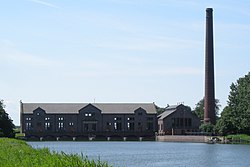Woudagemaal
| Ir.DF Woudagemaal | |
|---|---|
|
UNESCO world heritage |
|

|
|
| Wouda pumping station |
|
| National territory: |
|
| Type: | Culture |
| Criteria : | (i) (ii) (iv) |
| Reference No .: | 867 |
| UNESCO region : | Europe and North America |
| History of enrollment | |
| Enrollment: | 1998 (session 22) |
The Wouda pumping station ( Dutch Woudagemaal ) is located in the Dutch village of Tacozijl near the Frisian town of Lemmer on the IJsselmeer . It is the largest and only working steam pumping station in the world.
Surname
It got its name after the Dutch civil engineer Dirk Frederik Wouda, who was responsible for its construction as an employee of the water management office of the province of Friesland.
construction
The plan for the construction emerged in 1913 from the cooperation of the engineers Wouda and Dijxhoorn and was part of the Zuiderzeewerke , the largest Dutch hydraulic engineering project of the 20th century, as a result of which the IJsselmeer remained as a residual sea and the polders became a new province Flevoland were declared.
The building was erected in 1917 and 1918, although there was a delay in 1918 due to a lightning strike in a chimney. On October 7, 1920, the Wouda pumping station was inaugurated by Queen Wilhelmina and went into operation for the first time.
Technology and history
The machine house and the boiler house belong to the buildings of the plant . Four flood gates release the water into the IJsselmeer. The pumping station itself consists of four double steam engines, each with an output of 500 HP (approx. 368 kW) and two (8 in total) centrifugal pumps each . This means that 4,000 m³ (i.e. 4,000,000 l) per minute can be pumped into the IJsselmeer. Even today this corresponds to around 6% of the Frisian floods . Friesland is on average 52 cm below sea level .
Steam engines and pumps were products of the Jaffa machine factory in Utrecht .
Initially, the steam engines were fired with coal . Up to 24 workers were employed in the plant at that time. After the war, peat was even burned at times . In 1956 the coal-fired steam boilers were replaced by four new boilers. In 1967 the system was converted to oil firing. Since then, it has been heated with heavy oil and consumes 12 to 13 tons of it for a day of use.
To 1966 has Schöpfwerk Wouda alone the level of Friesland regulated. In that year, the JL Hoogland pumping station near Stavoren went into operation and runs electrically. Since then, the use of the Wouda pumping station has been limited to flood times; it only runs 5 to 6 times a year, together for around 20 days. The mission order comes from the Frisian provincial capital Leeuwarden . The last use was during the storm surges between January 11 and 23, 2007.
meaning
For many years, the Wouda steam pumping station formed the model for other systems around the world, a kind of standard for steam pumping stations. It has remained the largest steam pumping station and is the only one still in operation today.
Not only the technology, but also the architecture of the system in the style of the expressionist Amsterdam School is considered exemplary. It impressively implements the belief in technical progress. The industrial building looks like an elongated moated castle , surrounded by old trees and reeds. It can be viewed, if luck will, even in action. In October 2011, Princess Margriet opened a new visitor center.
Since 1977, the steam pumping station Wouda stands as Rijksmonument under monument protection .
1998 was Schöpfwerk Wouda by the UNESCO for World Heritage appointed, as it represents a high point for the protection of the people and the country against the forces of nature, here the water by the Dutch engineers and architects.
literature
- Natascha Albus, Michael Kaiser (Red.): The treasures of Europe - the most wonderful cultural and natural monuments of the "Old Continent" . Verlag Wolfgang Kunth, Munich 2006, ISBN 3-89944-157-5 .
Web links
- Official website for the pumping station (German, Dutch, English)
- The Wouda pumping station - treasures of the world . In: swr.de
Individual evidence
- ↑ Monument number: 25772. Rijksdienst voor het Cultureel Erfgoed, accessed on June 24, 2014 (Dutch).
- ↑ UNESCO World Heritage Committee Adds 30 Sites to World Heritage List. World Heritage Committee , December 2, 1998, accessed June 24, 2014 .
Coordinates: 52 ° 50 ′ 46 " N , 5 ° 40 ′ 46" E

